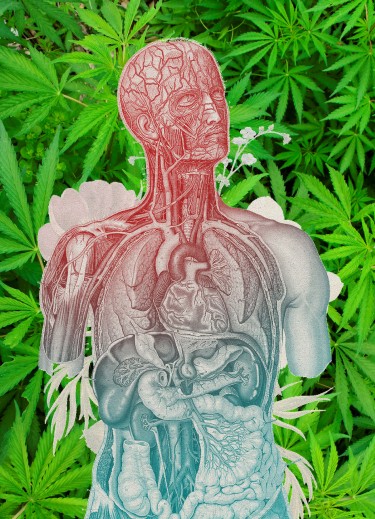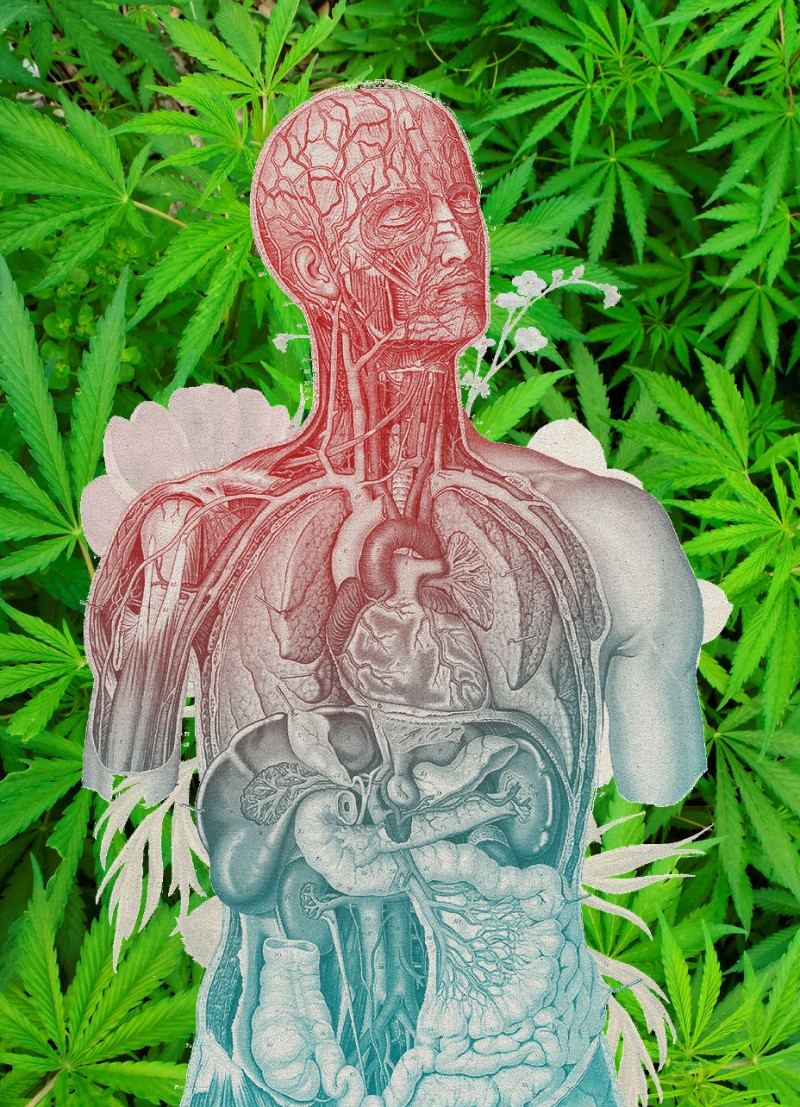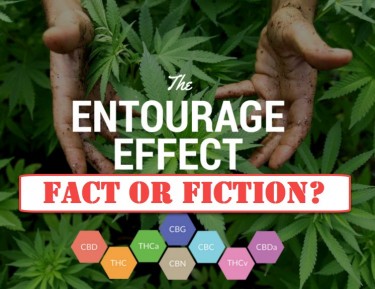
New Study Confirms the “Entourage Effect” of cannabis
In the ever-evolving discourse surrounding cannabis, two common refrains often surface from the corridors of political skepticism and legislative inertia. The first is a claim steeped in denial—asserting that the realm of cannabis research is barren, a wasteland lacking in scholarly inquiry. This, however, couldn't be farther from the truth. With over 20,000 published papers delving into the intricate world of cannabis, spanning its biochemical mechanisms to its therapeutic applications, the argument that cannabis is an understudied subject is a fallacy.
The second claim takes a more paradoxical stance. Critics argue that cannabis, in its natural form, harbors no inherent medical properties—a position seemingly contradicted by the widespread acknowledgment of the medicinal virtues of cannabinoids such as CBD and THC. Identified and studied since the early 1990s, these compounds have been the stars of the medicinal cannabis narrative, celebrated for their ability to alleviate a spectrum of ailments from chronic pain to anxiety. Yet, to reduce cannabis's therapeutic potential to the sum of its parts is to overlook the symphony of synergy that characterizes its true medicinal prowess.
Enter the concept of the "entourage effect"—a phenomenon suggesting that cannabis outperforms the isolated efficacy of its individual compounds through a harmonious interplay. This theory proposes that cannabinoids, terpenes, flavonoids, and other cannabis constituents work in concert, amplifying each other's effects and delivering a therapeutic ensemble greater than the sum of its solo performances. Recent research has lent credence to this notion, providing empirical support for the entourage effect and challenging the reductionist approach to cannabis's medicinal value.
In this article, we delve into the heart of this groundbreaking study, shedding light on the intricate dance of compounds within cannabis and how their collective action unfurls its therapeutic potential. By exploring the nuances of the entourage effect, we aim to expand our understanding of cannabis's complexity and celebrate the sophisticated interplay that makes it a unique and potent ally in the realm of medicine.
What is the Entourage Effect Exactly?
The concept of the "entourage effect" in cannabis science and therapy represents a paradigm shift in understanding how the plant's myriad components work in concert to produce therapeutic effects. This phenomenon, which underscores the synergy between cannabis compounds, challenges the notion that isolated cannabinoids like THC (tetrahydrocannabinol) or CBD (cannabidiol) alone account for the plant's medicinal properties. The term "entourage effect" was first introduced by renowned Israeli scientists Raphael Mechoulam and Shimon Ben-Shabat in 1998 to describe their findings that cannabis compounds could provide more significant health benefits together than when taken separately.
The entourage effect hinges on the premise that cannabis contains a complex constellation of over 100 cannabinoids, along with terpenes, flavonoids, and other phytochemicals, each contributing to the plant's therapeutic profile. When consumed, these compounds interact with the human body's endocannabinoid system (ECS), a vast network of receptors and neurotransmitters involved in maintaining physiological homeostasis. The interactions between cannabinoids and the ECS are well-documented, but the entourage effect suggests that terpenes and other cannabis constituents can modulate these interactions, enhancing the plant's overall therapeutic potential.
This intricate interplay explains why every cannabis strain exhibits a unique "therapeutic profile." Variations in the concentrations of terpenes, flavonoids, and cannabinoids among different strains can significantly influence their effects on the body. For instance, the terpene myrcene is known for its sedative properties, while limonene is associated with mood elevation. When these terpenes are present alongside cannabinoids in specific ratios, they can alter the effects of the cannabinoids, leading to a more nuanced and potentially more effective therapeutic outcome.
The analogy of a bundle of sticks, which becomes unbreakable when bound together, aptly illustrates the entourage effect's significance in medical cannabis. By combining multiple cannabis compounds, the entourage effect creates a robust medical effect, suggesting that the plant, having evolved with such complexity, was perhaps always intended for human consumption. This synergy not only amplifies the therapeutic benefits of individual compounds but also mitigates their adverse effects, providing a compelling argument for the whole-plant use of cannabis in medicine.
More about the recent study
A recent study reviewed the collaborative interactions and synergies between the various phytochemicals in cannabis, including cannabinoids, terpenes, and flavonoids. It highlighted the concept of the "entourage effect," which refers to the synergistic or additive effects obtained from the combined action of these compounds, surpassing their individual efficacy.
The key findings underscored that cannabinoids exhibit analgesic, anti-inflammatory, and neuroprotective properties, while terpenes not only contribute to the sensory profile of cannabis but also modulate cannabinoid effects through various mechanisms. Additionally, flavonoids demonstrate anti-inflammatory, antioxidant, and neuroprotective capabilities, with relevance to neuroinflammation.
Preclinical evidence demonstrates the interaction between phytocannabinoids and terpenes, suggesting enhanced medical benefits of full-spectrum cannabis extracts compared to isolated compounds, attributable to the entourage effect. However, unfavorable interactions can also occur. Careful selection of active phytomolecules and reduction of inactive or potentially pro-inflammatory compounds may optimize therapeutic activity.
These findings highlight the potential of cannabis medicine to provide more comprehensive and robust therapeutic responses by harnessing the collective strength of the various phytochemicals through the entourage effect. This underscores the importance of delving into the intricate synergistic roles of the compounds to unlock cannabis's full therapeutic potential within natural plant-based medicine.
Moreover, the authors emphasized elucidating the synergistic effects and mechanisms, comprehending phytochemical production and accumulation mechanisms under varying conditions, conducting comprehensive phytochemical characterization of cannabis strains, addressing regulatory barriers obstructing research, and recognizing the value of non-phytocannabinoid compounds.
Overall, this review highlighted the imperative to explore the nuanced interactions between the various cannabis constituents. Doing so and overcoming research barriers can pave the way for developing more personalized and productive cannabis-based medicinal interventions. Ultimately, comprehensively harnessing the synergies between the phytochemicals holds the key to unraveling the full scope of cannabis’s therapeutic potential.
Whole Plant vs Compound-Specific Medicine
Whole plant medicine and compound-specific medicine represent two distinct approaches to using cannabis for therapeutic purposes. Both have their unique advantages and applications, depending on the individual's needs and the specific health conditions being addressed.
Whole Plant Medicine emphasizes the use of the entire cannabis plant, including its full spectrum of cannabinoids, terpenes, and other phytochemicals. This approach is grounded in the "entourage effect," a theory suggesting that the therapeutic impact of the entire plant is greater than the sum of its parts. The synergistic interaction among cannabis compounds can enhance efficacy and reduce side effects. Whole plant medicine might be particularly beneficial for individuals with complex conditions like chronic pain, multiple sclerosis, or epilepsy, where this synergistic effect can offer broad-spectrum relief. It is also favored by those seeking a more natural and holistic approach to treatment, as it utilizes the plant in a form that's closer to its natural state.
Compound-Specific Medicine, on the other hand, focuses on isolating specific cannabinoids (such as THC or CBD) to target particular symptoms or conditions with precision. This approach allows for standardized dosing and the ability to tailor treatments to the individual's specific needs, potentially reducing unwanted side effects. Compound-specific medicines are particularly useful in research settings where isolating variables is essential for understanding the effects of individual cannabinoids. Conditions that require a precise dosage for relief or management, such as certain types of severe epilepsy treated with CBD, may benefit more from this approach.
In deciding between whole plant medicine and compound-specific medicine, several factors come into play. Whole plant medicine may be better suited for individuals looking for a holistic treatment option that leverages the entourage effect for potentially broader therapeutic benefits. It is ideal for those whose conditions benefit from the synergistic effects of multiple cannabis compounds.
Compound-specific medicine, by contrast, offers a targeted approach that can be critical for conditions requiring precise dosages of specific cannabinoids. This method can be particularly beneficial for patients and healthcare providers looking to minimize psychoactive effects or focus on a singular therapeutic aspect of cannabis.
Ultimately, the choice between whole plant and compound-specific medicine depends on the individual's unique medical needs, the specific condition being treated, and personal preferences regarding cannabis use. Both approaches offer valuable therapeutic potential, and ongoing research continues to deepen our understanding of when and how each can be most effectively employed.
The Sticky Bottom Line
The entourage effect, substantiated by recent research, amplifies the discourse surrounding the therapeutic applications of cannabis, showcasing the nuanced interplay between whole plant medicine and compound-specific medicine. This phenomenon, where the therapeutic benefits of cannabis are enhanced by the synergistic interaction of its myriad compounds, underscores the complexity and sophistication of the plant's medicinal properties.
The advent of the entourage effect study brings to light the limitations of a reductionist approach that has long dominated cannabis research, focusing solely on isolated compounds like THC and CBD. While compound-specific medicine has its merits, particularly in providing targeted treatments for specific conditions and allowing for precise dosing, it overlooks the holistic benefits inherent in the full spectrum of cannabis's phytochemicals.
Whole plant medicine, on the other hand, offers a broader therapeutic potential by harnessing the full array of cannabinoids, terpenes, and flavonoids found within the cannabis plant. This approach aligns with the principles of the entourage effect, suggesting that the plant's natural composition can offer more comprehensive relief for a wide range of symptoms and conditions than isolated compounds alone. Whole plant medicine may be particularly advantageous for complex, multifaceted conditions where the interplay of multiple compounds can provide a more balanced and effective treatment.
However, the choice between whole plant and compound-specific medicine is not a one-size-fits-all decision. It requires a personalized approach, considering the individual's specific health needs, the condition being treated, and the desired outcomes. For some, the precision and predictability of compound-specific medicine may be preferable, especially in cases where the psychoactive effects of THC need to be minimized. For others, the broader, synergistic benefits of whole plant medicine may offer a more effective solution.
In conclusion, the entourage effect reinforces the importance of considering the cannabis plant in its entirety, highlighting the potential shortcomings of focusing solely on individual compounds. As cannabis research continues to evolve, it is imperative that both whole plant and compound-specific approaches are explored and understood. This will enable healthcare providers and patients to make informed decisions, tailoring cannabis-based treatments to best meet the individual's needs and maximize therapeutic outcomes. The sticky bottom line is that both whole plant medicine and compound-specific medicine have their place in the therapeutic landscape of cannabis, and the choice between them should be guided by a nuanced understanding of the entourage effect and the specific needs of the individual.






